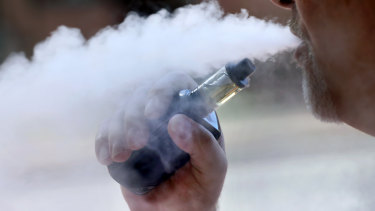Australia has been wise in not bowing to the demands of lobby groups seeking to have federal and state governments ease restrictions on vaping. The cautious approach should be universally maintained until much more is known about the medical risks of electronic smoking.
What was a fad only a few years ago has become almost mainstream, especially among young people, who have largely shunned traditional cigarettes. The common perception is that vaping is “safer” than smoking cigarettes, which contain tar and chemicals as well as the addictive substance nicotine.
While anecdotal evidence indicates that many thousands of vapers who use nicotine have successfully given up smoking, that does not mean vaping, in itself, is safe. Credit:AP
But serious medical issues directly associated with vaping are emerging, and alarm bells are ringing. In the United States, the Centres for Disease Control and Prevention is leading a multi-agency investigation, including federal and state-based medical authorities and the US Food and Drug Administration, in an effort to discover what is causing a deadly lung disease among hundreds of vapers.
Five people, all of whom used vaping products, have died in recent weeks from a rapid-onset form of the lung disease that has emerged in 33 states. The FDA has said common themes appear to be the vaping of some tetrahydrocannabinol, the psychotropic ingredient in marijuana that alters brain function and perception; or vitamin E acetate, an oil found in vitamin E products and in certain strands of cannabis.
Vaping devices burn liquid substances on tiny hot coils. As the user inhales, the substance vaporises and is drawn into the lungs. There are many thousands of varieties of vaping substances, and many vapers mix their own formulas from food flavourings, preservatives, synthetic coolants and more. Many add nicotine.
The problem is that no one genuinely knows what is happening to users when they subject their respiratory systems to these super-heated chemical concoctions. Legal as the non-nicotine substances might be, very significant questions remain about the potentially carcinogenic or medically compromising effects of vaping.
Decades of rigorous research into tobacco products has proved categorically that cigarette and cigar smoking is addictive and dangerous, and that smoking causes cancers affecting lungs, throat, mouth, stomach, liver, pancreas, bladder and more. Medical research has also proved that inhaling smoke from other people’s cigarettes or being in environments where smoking prevails can cause cancer.
But there have not been any longitudinal studies about the effects of vaping. And, while there is no evidence about effects on the primary user, nor is there any medical evidence about potential effects on people nearby. Oddly enough, the US Transportation Department did not ban the use of vaping products on airline flights until 2016, when it reacted to concerns about inhalation of aerosol fumes by other passengers.
Earlier this year, the American Journal of Public Health noted several companies were advertising their vaping products as “vitamin delivery devices”, “weight management aids” and devices for delivering “nutritional supplements”. The marketing theme revolves around vaping being “clean” or at least a healthier choice than cigarettes.
While anecdotal evidence indicates that many thousands of vapers who use nicotine have successfully given up smoking, and while it is encouraging that vaping substances do not contain tar, that does not mean vaping, in itself, is safe.
Australian health officials must urgently initiate comprehensive research into the rapidly growing habit and closely monitor what US authorities are discovering. We cannot afford to have another generation affected by debilitating, smoking-related illnesses.
Source: Read Full Article

